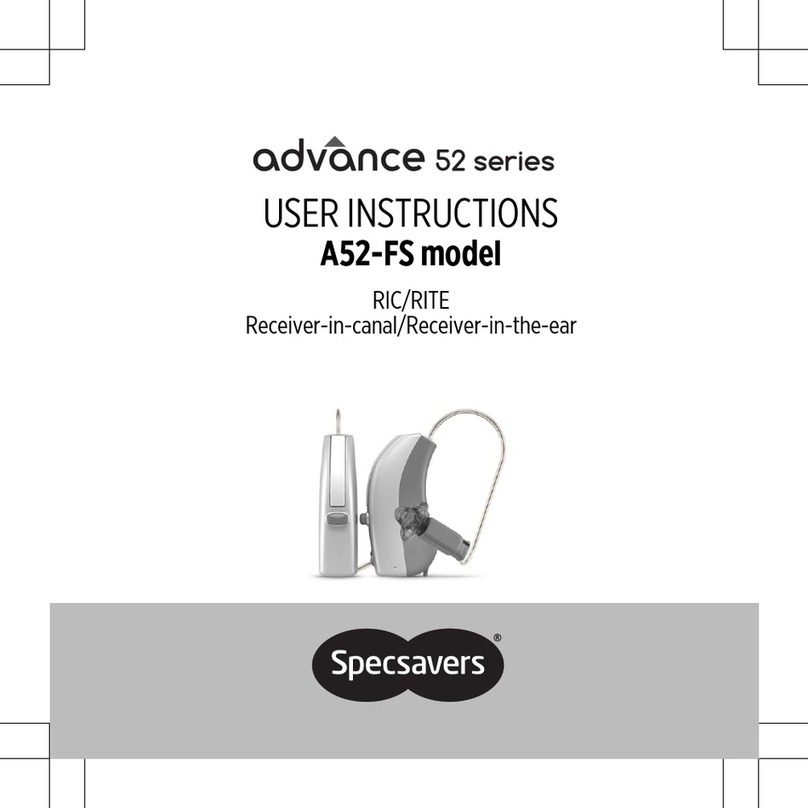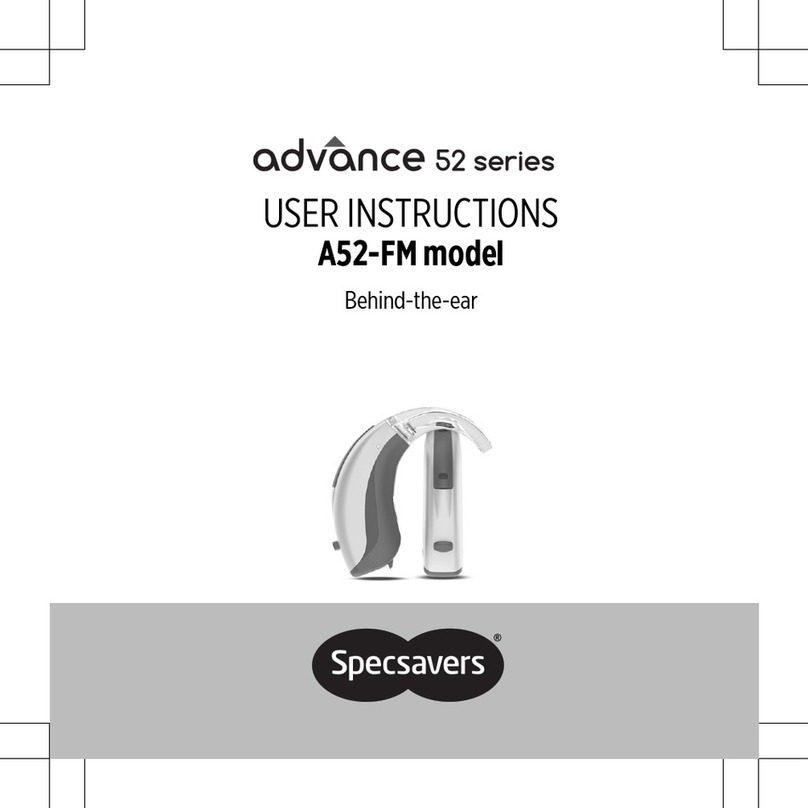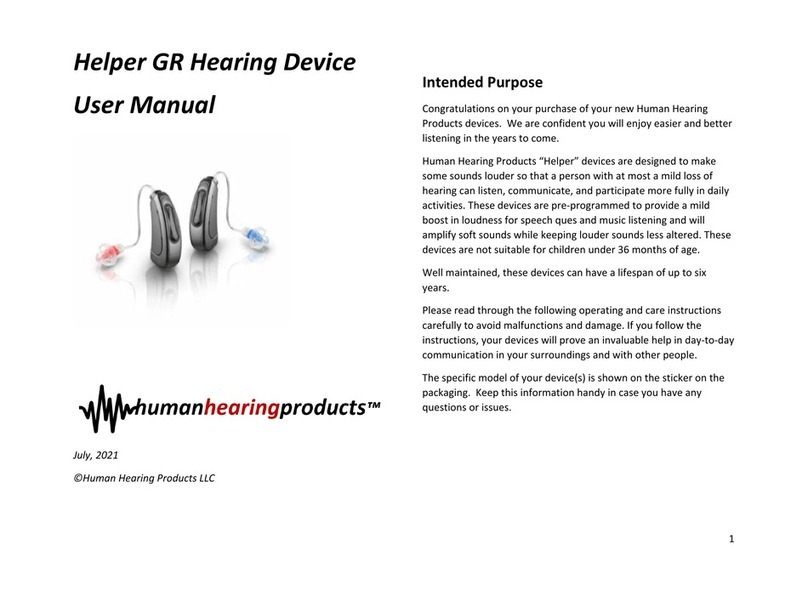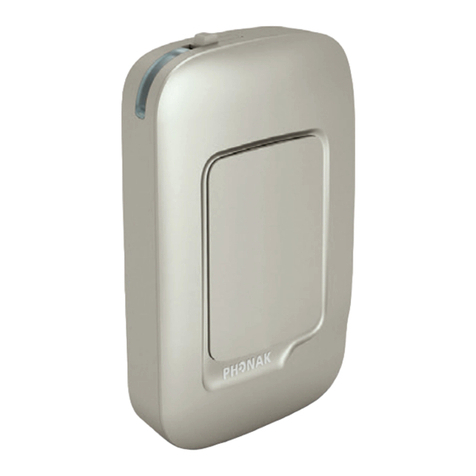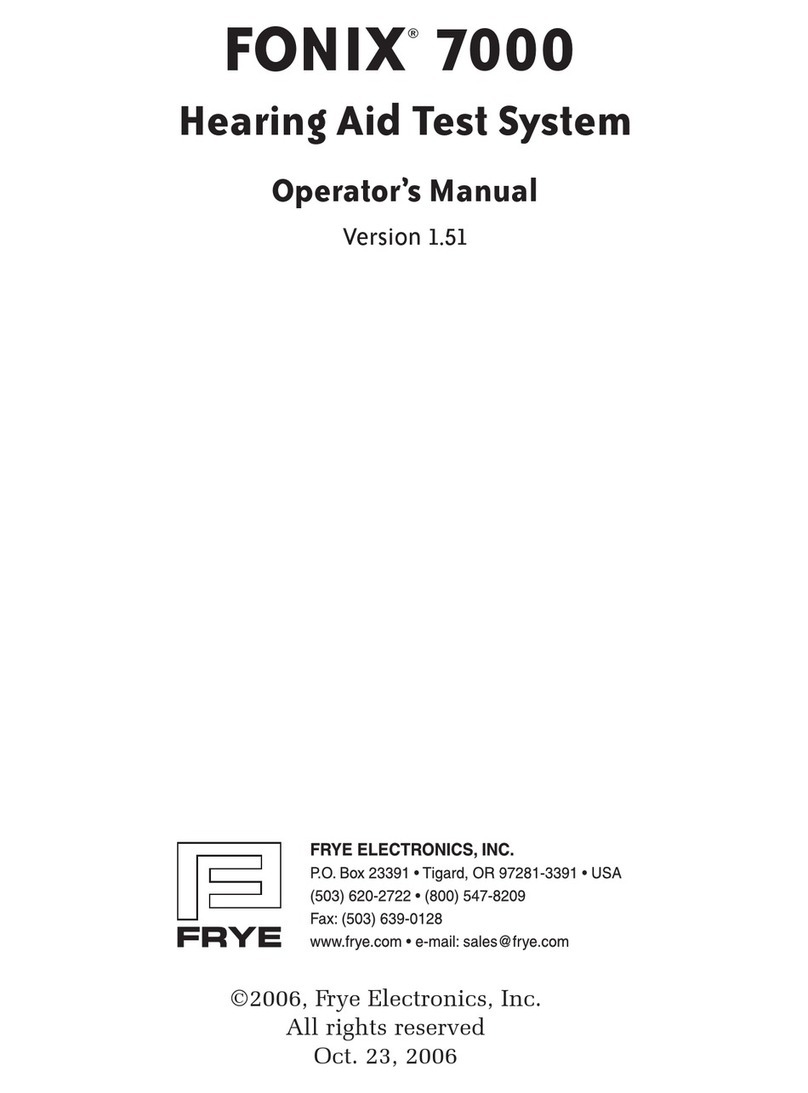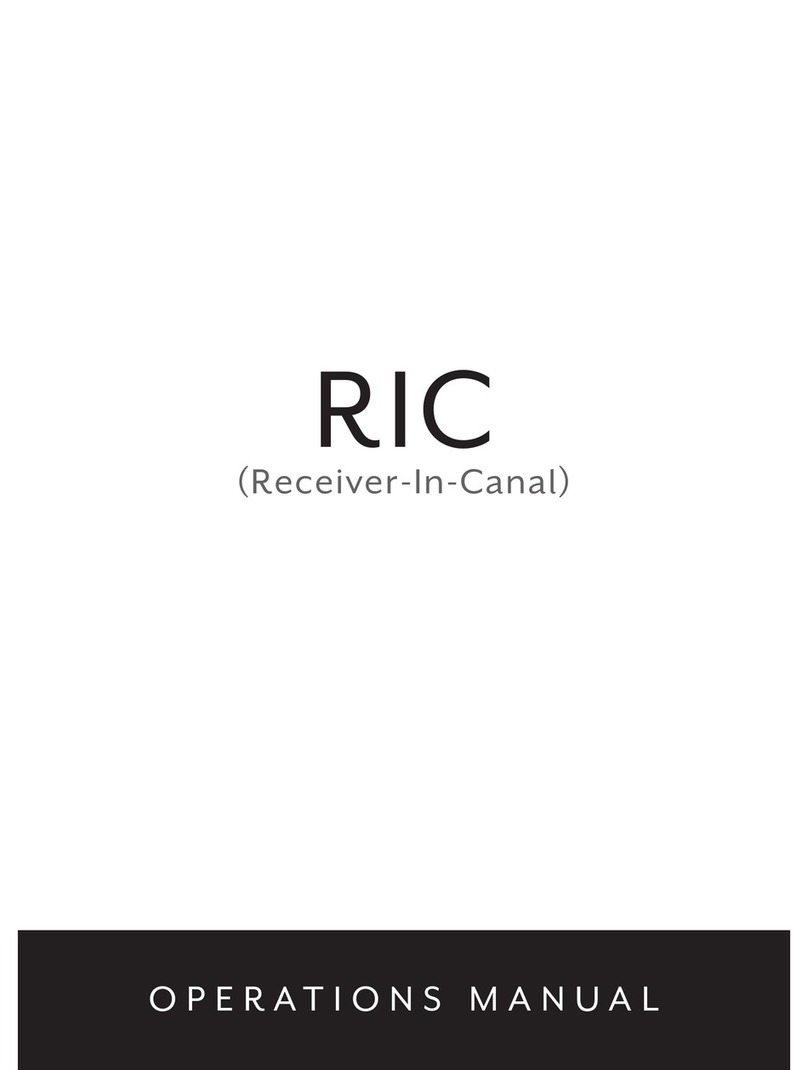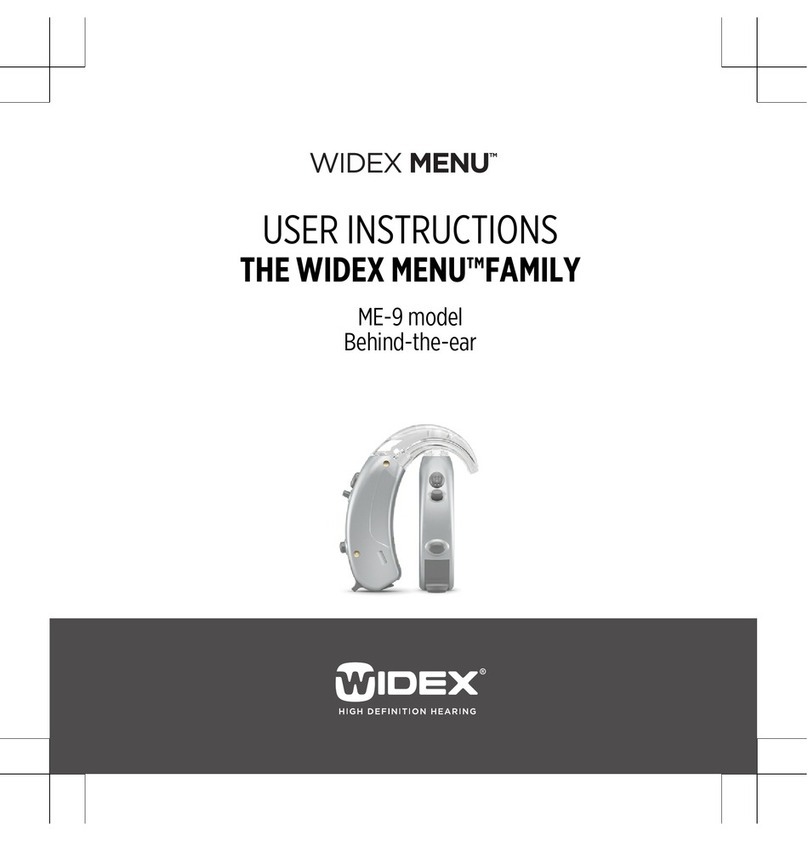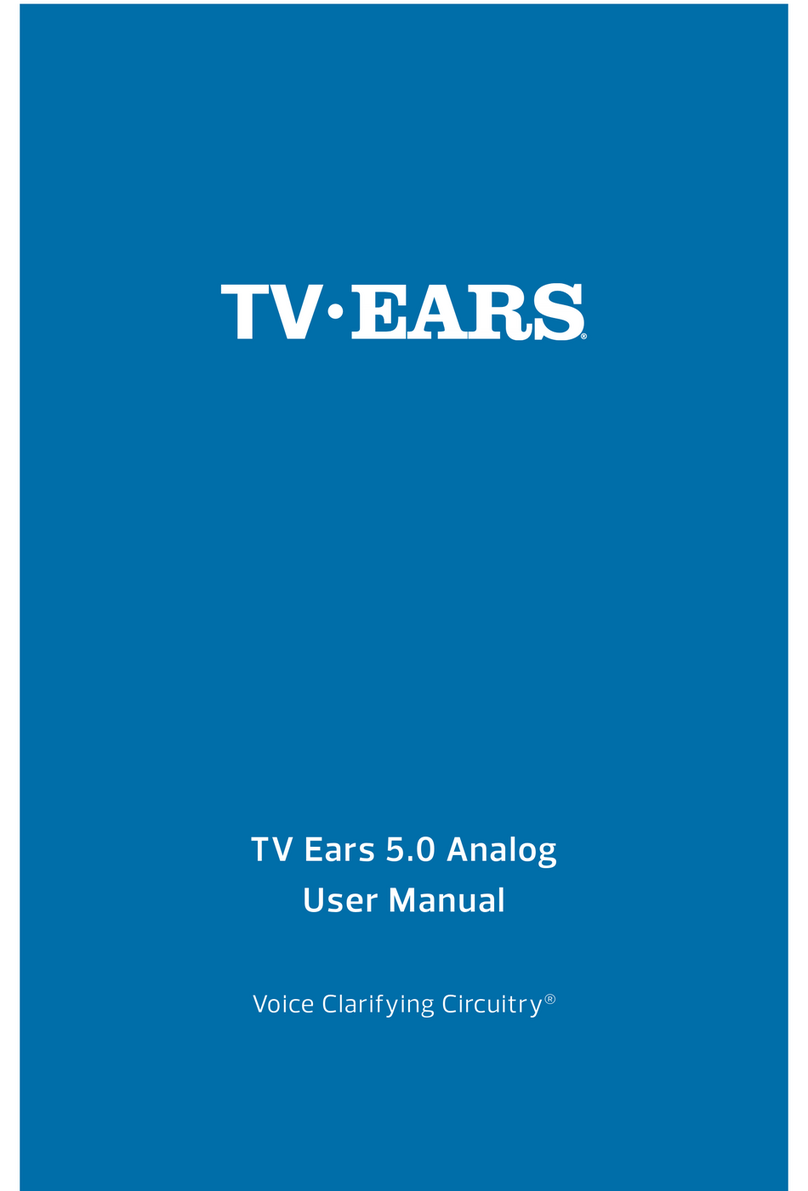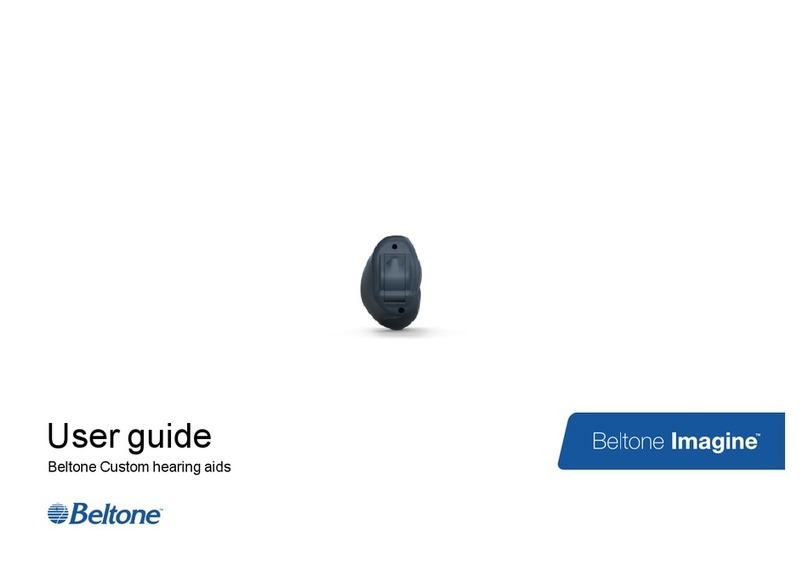Specsavers A52-CIC User manual

USER INSTRUCTIONS
A52-CIC/A52-CIC (TR)/A52-CIC M/A52-
CIC M (TR) model
Completely-in-canal

YOUR HEARING AID
(To be filled out by the hearing care professional)
Vent: Short Full length None
CIC CIC-M
Your hearing aid series:
PROGRAMS
Universal Audibility Extender
Quiet Audibility Extender
Transport Audibility Extender
Urban Audibility Extender
Party Audibility Extender
Music Audibility Extender
SPECIAL PROGRAMS
Zen Audibility Extender
Phone Audibility Extender
Zen+ Audibility Extender
2

NOTE
The program names in the table are the default names. If you have chosen to
use some of the other names available, write the new names in the table. That
way you will always know which programs you have in your hearing aids.
NOTE
The CIC-M is not a wireless hearing aid, which means that the hearing aids
cannot communicate with each other or with any accessory. Consequently,
you cannot adjust the sound and you will only have one listening program.
3

CONTENTS
YOUR HEARING AID...................................................................................6
Welcome...........................................................................................................6
Important safety information.........................................................................7
THE HEARING AID......................................................................................9
Indications for use........................................................................................... 9
Intended use.....................................................................................................9
The battery.......................................................................................................9
Sound signals...................................................................................................11
How to tell right from left..............................................................................12
Turning the hearing aid on and off...............................................................12
Putting on and removing your hearing aid.................................................13
Sound adjustment..........................................................................................14
Programs.........................................................................................................15
CLEANING.................................................................................................18
Tools.................................................................................................................18
Cleaning the hearing aid................................................................................18
The wax guard................................................................................................21
ACCESSORIES.......................................................................................... 24
TROUBLESHOOTING................................................................................ 25
REGULATORY INFORMATION...................................................................28
4

YOURHEARINGAID
Welcome
Congratulations on your new hearing aid.
Use your hearing aid regularly, even if it takes some time getting used to it.
Infrequent users don’t usually get the full benefit of a hearing aid.
NOTE
Your hearing aid and its accessories may not look exactly as illustrated in this
booklet. We also reserve the right to make any changes we consider necessary.
Your hearing aid at a glance
1. Microphone openings
2. Battery lid (on/off function)
3. Nail grip
4. Sound outlet
5. Wax guard
6. Extraction cord
7. Relief vent (short)
8. Relief vent (full length)
6

Important safety information
Read these pages carefully before you begin using your hearing aid.
Hearing aids andbatteries can be dangerous if swallowed or used im-
properly. Swallowing or improper use can result in severe injury or even
fatalities. In case ofingestion, contact your local emergency number or
hospital immediately.
Take your hearing aids out when you are not using them. This will help to
ventilate the ear canal and prevent ear infections.
Contact your doctor orhearing care professional immediately if you sus-
pect you may have an ear infection or an allergic reaction.
Contact your hearing care professional if the hearing aid doesn't feel
comfortable, or if it doesn't fit properly, causing irritation, redness or the
like.
Remove your hearing aids before showering, swimming or using a hair
dryer.
Do not wear your hearing aids when applying perfume, spray, gels, lotion
or cream.
Do not dry your hearing aid in a microwave oven - this will ruin it.
Never use other people’s hearing aids and never allow others to use
yours, as this could damage your hearing.
Never use your hearingaids in environments where there may be explo-
sive gases, such as in mines, etc.
7

Keep hearing aids, their parts, accessories and batteries away from chil-
dren and mentally disabled people.
Never try to open or repair the hearing aid yourself. Contact your hearing
care professional if you need to have your hearing aid repaired.
Your hearing aids contain radio communication technology. Always ob-
serve the environment in which you are using them. If any restrictions ap-
ply, you must take precautions to comply with these.
Do not expose your hearing aids to extreme temperatures or high humid-
ity, and dry them quickly if they get wet, or if you perspire heavily.
Your hearing aids should be stored and transported within the temperature and
humidity ranges of -20°C to +55°C (-4°F to 131°F) and 10%-95% rH.
Your hearing aids are designed to operate from 0°C (32°F) to 50°C (122°F).
For more information about your hearing aids, visit: www.specsavers.com.
8

THEHEARINGAID
Indications for use
The hearing aids are indicated for individuals older than 36 months with a
range of hearing loss from minimal (10 dB HL) to severe (90 dB HL) and all
hearing loss configurations.
They are to be programmed by licensed hearing care professionals (audiol-
ogists, hearing aid specialists, otolaryngologists) who are trained in hearing
(re)habilitation.
Intended use
The hearing aids are intended as air conduction amplification devices to be
used in everyday listening environments. The hearing aids may be equipped
with the Zen program intended to provide a relaxing sound background (i.e.
music/noise source) for adults who desire to listen to such a background in
quiet.
The battery
Use a type 10 zinc-air battery for your hearing aid.
Always use a fresh, new battery that is precisely the kind recommended by
your hearing care professional.
9

NOTE
Check that the batteryis completely clean and free of any residue before insert-
ing it in the hearing aid. Otherwise your hearing aid may not function as expec-
ted.
Never attempt torecharge your hearing aid batteries, as they could ex-
plode.
Never leave a flat battery in the hearing aids while storing them. It could
leak and ruin your hearing aid.
Dispose of used batteries as indicated on the packaging and take note of
the expiry date.
Low battery indication
When the battery is flat, a sound signal will play. If the battery drains sud-
denly there may however be no warning. We recommend carrying a spare
battery with you wherever you go.
Changing the battery
To change the battery, do as follows: Take the adhesive tab off the new
battery and make sure there is no
sticky substance left on it. Let it
"breathe" for 60 seconds.
Use the nail grip to gently swing the
battery door open and remove the
old battery.
10

Now place the new battery in the
drawer as shown. Close the drawer. If
it doesn't close easily, the battery is
not placed correctly.
If you are not using the hearing aid
for a few days, remove the battery.
NOTE
Avoid dropping your hearing aid - hold the hearing aid above a soft surface
while changing the battery.
Sound signals
Your hearing aid plays sounds to inform you that certain features have been
activated or that you have changed programs. These sounds may be spoken
messages or tones, depending on your needs and preferences.
Program 1 Message/one short beep
Program 2 Message/two short beeps
Program 3 Message/three short beeps
Program 4 Message/one short and one long beep
Program 5 Message/one long beep and two short beeps
Zen+ Message/tone
11

Ask your hearing care professional to turn these sounds signals off if you
don't need them.
Lost partner
(Only available in top models)
Your hearing care professional can turn on a feature in your hearing aid that
warns you whenever it loses contact with the hearing aid in the opposite
ear. You will hear a spoken message in your ear.
How to tell right from left
The hearing aid for your right ear has a red mark. The hearing aid for your
left ear has a blue mark.
Turning the hearing aid on and off
To turn the hearing aid on, close the battery cover
and push it upwards. The hearing aid will play a
sound signal to indicate that it is on, unless your hear-
ing care professional has deactivated this function.
12

To turn off the hearing aid, push the battery cover
downwards.
NOTE
You can also cup the hearing aid in your hand to verify that it is turned on. If it's
on, it will whistle. Don't forget to turn off the hearing aid when it is not in use.
Putting on and removing your hearing aid
Close the battery lid completely. Hold the hearing aid
with your thumb and forefinger and insert it slowly into
your ear until you feel resistance.
Then use the tip of your forefinger to gently push the
hearing aid into your ear until it feels comfortable.
Pulling the outer ear upwards and backwards while you
insert the hearing aid can be helpful.
13

Removing the hearing aid
Use the extraction cord to take the hearing aid out of
your ear.
NOTE
If you find it difficult to takeout the hearing aid, move it carefully from side to
side while pulling on the extraction cord.
Sound adjustment
Your hearing aid adjusts the sound automatically according to your sound
environment.
If you have a remote control, you can also adjust the sound manually to ach-
ieve more comfort or more audibility, depending on your needs and prefer-
ences. For more information on how this works, consult your hearing care
professional.
Depending on the hearing aid settings and features, any sound adjustment
you make will affect both hearing aids.
Each time you operate the volume control, you will hear a beep-tone unless
your hearing care professional has deactivated this function. When you
reach the maximum or minimum setting, you will hear a steady tone.
14

To mute your hearing aid do as follows:
●Keep pressing the lower part of the volume key on the remote control
until you can hear the steady sound
To turn the sound on again:
●Press the upper part of the volume key or
●Change program
Any adjustment of the volume will be cancelled when you turn off your
hearing aid or if you change program.
Programs
PROGRAM USE
Universal For everyday use
Quiet Special program for listening in quiet environ-
ments
Transport For listening in situations with noise from cars,
trains, etc.
Urban For listening in situations with changing sound
levels (in supermarkets, noisy workplaces or sim-
ilar)
Party For listening in situations with many people talk-
ing at the same time
15

PROGRAM USE
Music For listening to music
SPECIAL PROGRAMS USE
Zen Plays tones or noise for a relaxing sound back-
ground
Phone This program is designed for listening to phone
conversations
Zen+ This program is similar to Zen but allows you to
listen to different types of tones or noise
NOTE
The names in the list of programs are the default names. Your hearing care pro-
fessional can also select a program name from a preselected list. Then it is even
easier for you to select the right program in each listening situation.
Depending on your hearing loss, your hearing care professional can activate
the Audibility Extender feature. Ask your hearing care professional if you
could benefit from this.
If your needs and preferences change over time, your hearing care profes-
sional can easily change your program selection
16

The Zen program
Your hearing aidmay be provided with a unique optional listening program
called Zen. It makes musicaltones (and sometimes a rushing noise) in the back-
ground.
If you perceive a decrease in loudness, tolerance of sounds, speech not as
clear, or worsening tinnitus, contact your hearing care professional.
Use of the Zen program may interfere with hearing everyday sounds in-
cluding speech. It should not be used when hearing such sounds is impor-
tant. Switch the hearing aid to a non-Zen program in those situations.
Changing programs
To change programs, simply push the program key on your remote control.
Zen+
To access this program, press and hold the program key for more than one
second. A quicker press then allows you to cycle through the available Zen
styles. To exit the program, press and hold down the program key for more
than one second.
17

CLEANING
Tools
You will receive the following cleaning tools with your hearing aid:
1. 2. 3. 4. 5.
1. Cloth
2. Brush
3. Long wax-removing tool
4. Short wax-removing tool
5. Battery magnet
Cleaning the hearing aid
Cleaning your hearing aid every day will make it more efficient and more
comfortable to wear.
The hearing aid Just wipe it with the a soft cloth (for exam-
ple the cloth you received from your hearing
care professional).
18

The sound outlet Remove any visible earwax from around the
sound outlet with the small brush or cloth. Nev-
er try to clean the wax guard.
NOTE
If you can't clean the sound outlet, contact your hearing care professional. Never
insert anything into the sound outlet as this can ruin your hearing aid.
The microphone openings Open the battery lid and turn the hearing aid
so the lid is facing downwards (see illustra-
tion). Guide the short wax removing tool (no.
4 ) through the microphone openings on the
lid from the inside (see illustration).
NOTE
If you suspect that earwax or dirt has got into the microphone inside the hearing
aid, contact your hearing care professional. Do not insert anything into the mi-
crophone.
19

The vent Short vent: clean the vent as far as the long end
of the wax removing tool (no. 3) can reach.
Long vent: clean the vent every day by passing
the long wax removing tool (no. 3) all the way
through the vent.
Leave the hearing aid open to ventilate it.
NOTE
It is important for the performance of your hearing aid that you keep the vent
clean and free of earwax, dirt or the like. Clean it every day after use and consult
your hearing care professional if the vent is blocked.
Dry your hearing aid quickly if it gets wet, or if you perspire heavily. Some
people use a special dehumidifier like Widex Dry-Go to help keep their hear-
ing aids dry and clean. Ask your hearing care professional if this is right for
you.
Do not use any kind of liquid or disinfectant to clean your hearing aid.
Clean and inspect yourhearing aid every day after use to check that it is
not broken. If the hearing aid breaks while you are wearing it, leaving
small fragments in your ear canal, contact your doctor. Never try to take
out the fragments yourself.
20
This manual suits for next models
4
Table of contents
Other Specsavers Hearing Aid manuals
Popular Hearing Aid manuals by other brands
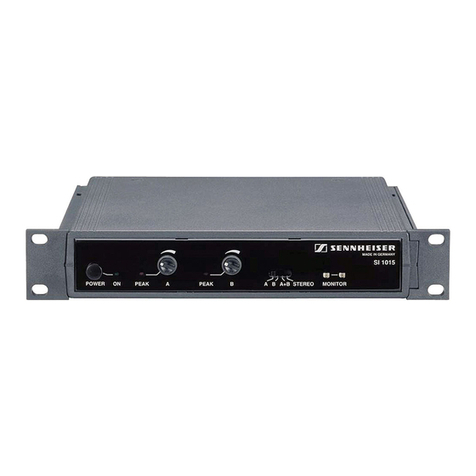
Sennheiser
Sennheiser SI 1015-4000 SINGLE Product sheet
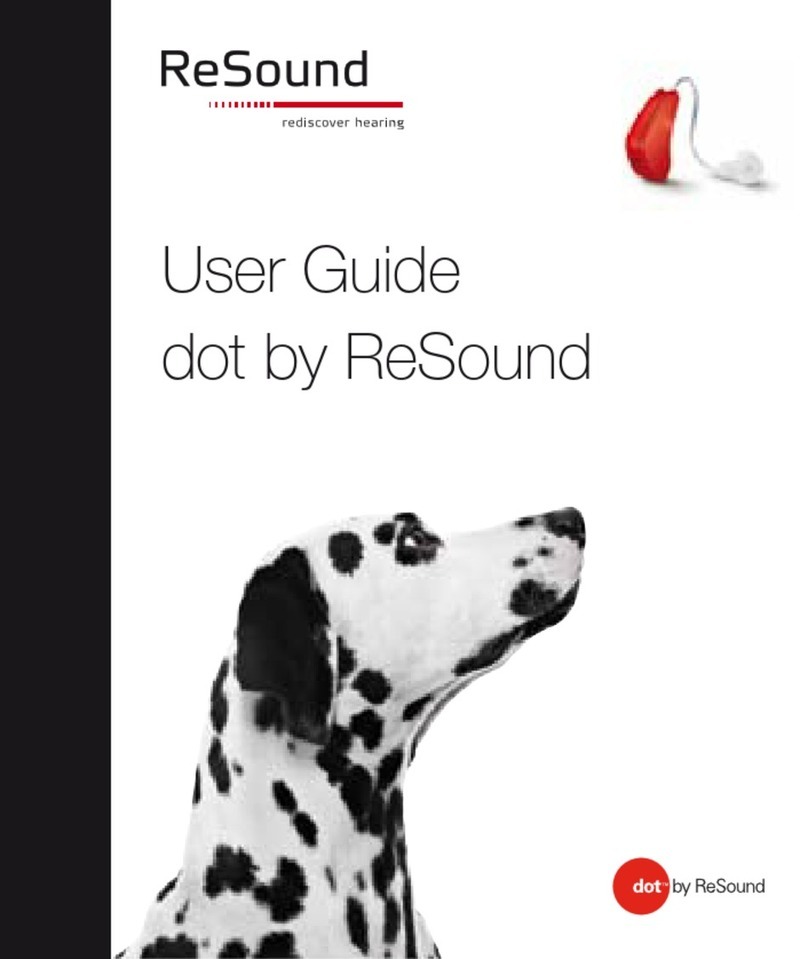
ReSound
ReSound dot DT3060 Open user guide

signia
signia Pure 312 Nx user guide
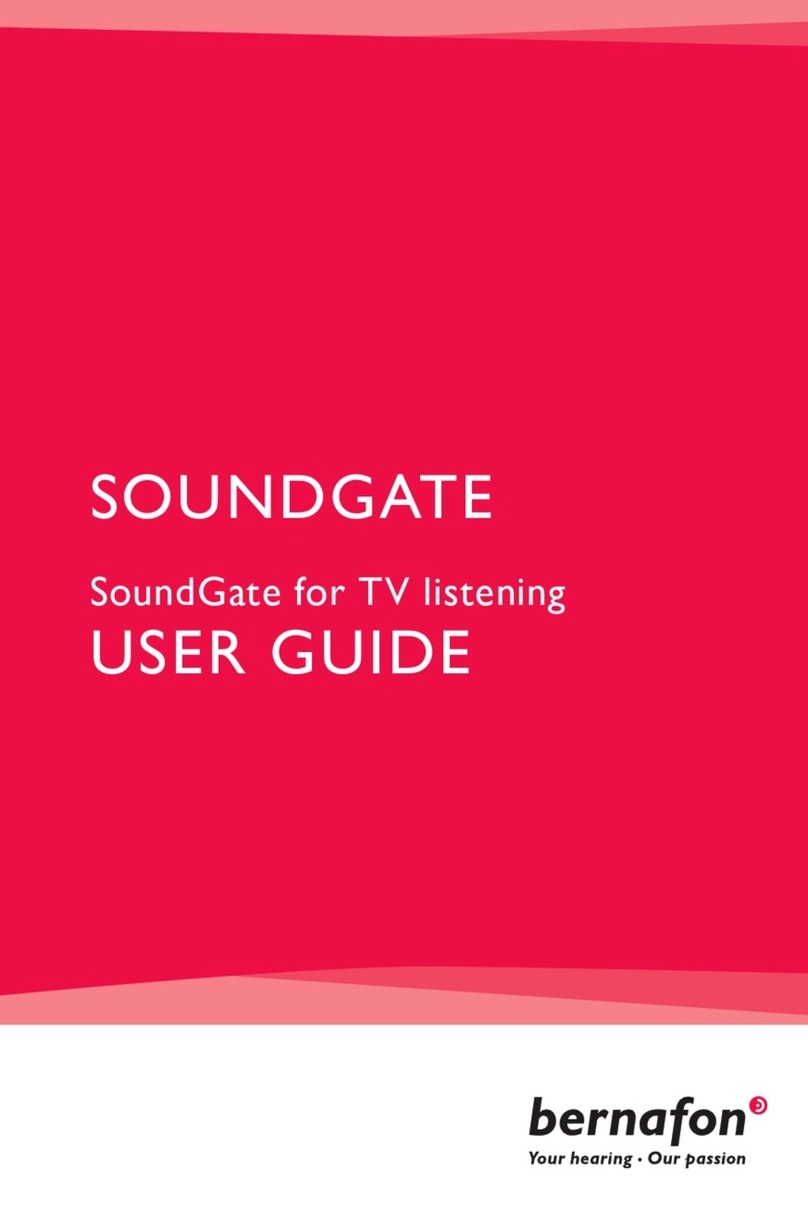
Bernafon
Bernafon SOUNDGATE user guide
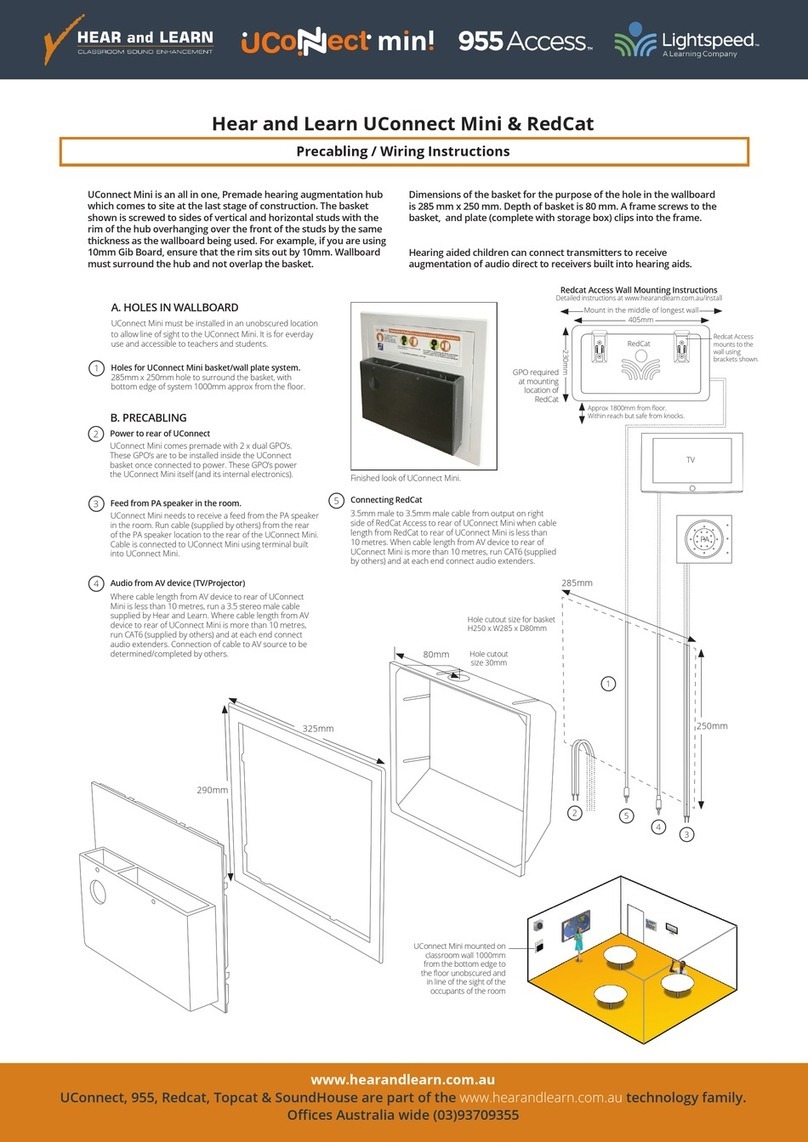
Hear and Learn
Hear and Learn UConnect Mini & RedCat Precabling / Wiring Instructions
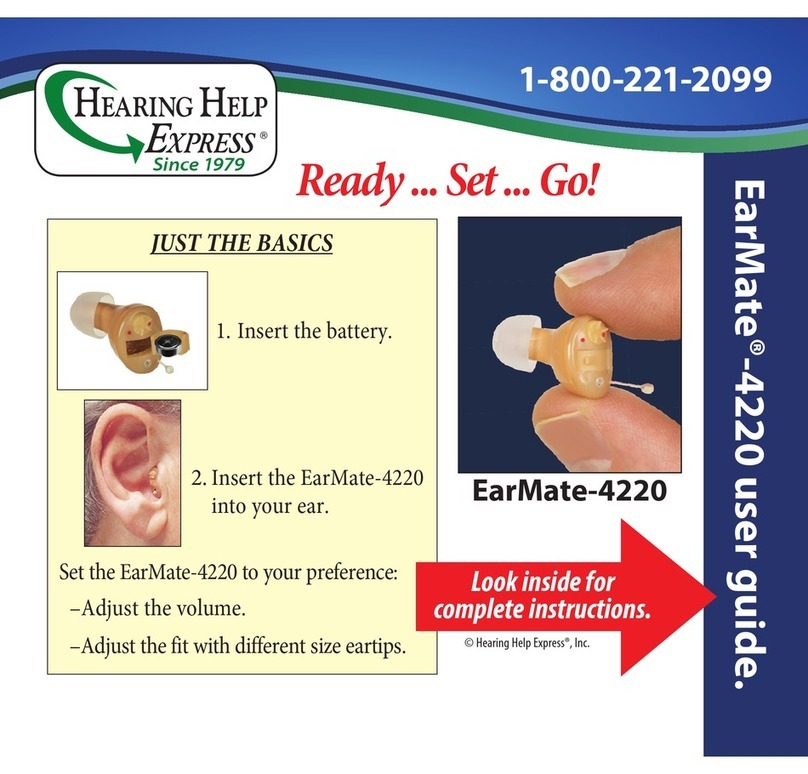
Hearing Help Express
Hearing Help Express EarMate-4220 user guide


